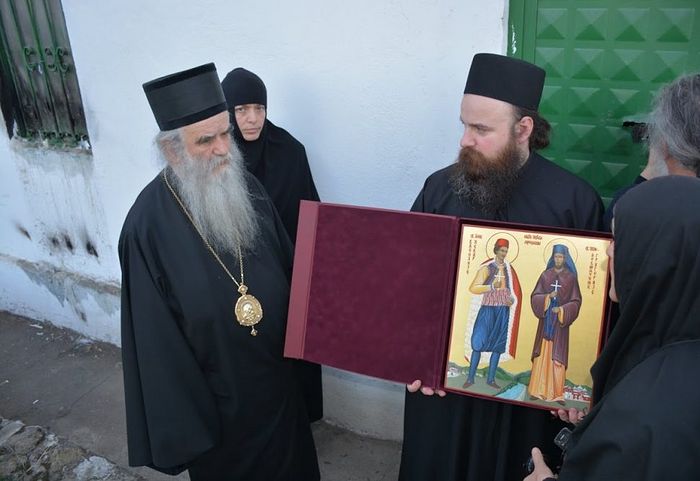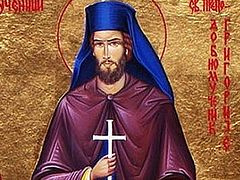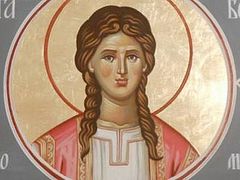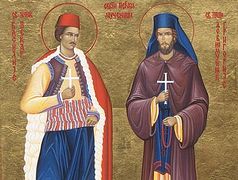In May 2018, the Holy Council of Bishops of the Serbian Church canonized among the saints three martyrs of Christ who suffered under the Turkish yoke: Monk Grigorije of Peć, Vasilije the baker of Peć, and the virgin Bosiljka from Pasjana. The solemn glorification of the three saints took place in the Church of St. Sava on May 10, 2018 during the Divine Liturgy on the day of the burning of the relics of St. Sava.
Thus, the Serbian Orthodox Church ratified the long-standing prayerful veneration of the newly-glorified holy martyrs among the faithful of the Serbian people, firstly of Kosovo and Metohija, where they suffered.
In these days, where the suffering of the Serbian Orthodox people in Kosovo and Metohija continues, the glorification of these martyrs was a great consolation and support for the faithful and a reminder to Serbs that their forefathers were ready to lay down their lives for the name of Christ.
Today we will acquaint you with the podvig of one of the newly-glorified saints—the holy New Martyr Vasilije, the baker from Peć.
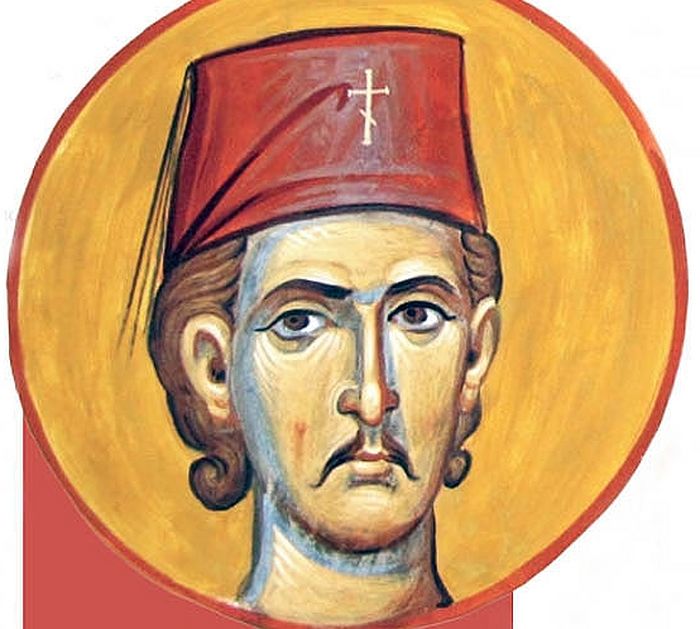 New Martyr Vasilije, the baker from Peć
New Martyr Vasilije, the baker from Peć
In the seventeenth century, Christians in the Balkans suffered under Turkish tyranny. This difficult cross was carried by the Serbs living in the ancient region of Metohija, known for its holy sites. It was enough to blame someone for blasphemy against the faith of Mohammed and he would be handed over to a cruel death without a trial or investigation. The abduction of Serbian women and girls was a regular occurrence.
In those severe times in the town of Peć, located near the famous Peć Patriarchate, there lived a pious Christian by the name of Vasilije. He was a baker by profession, but in his soul he was a true citizen of the Heavenly Kingdom. Vasilije was a diligent family man; he honored the holiness of marriage and by the age of thirty-five, like the majority of people of that age, he had already nearly-grown children.
His daughter possessed a special beauty. Approaching the age of marriage, she began to attract the watchful attention of the local Turks. One day, inflamed by carnal passion, they kidnapped her from her parents’ home.
St. Vasilije, as a man deeply rooted in his father’s faith, could not endure such lawlessness, all the moreso because his daughter might be converted to Islam. He pursued the Turks and entered into a struggle for his child. Outnumbering him, the Turks overpowered Vasilije, began to severely beat him, and tried to force him to accept Mohammedanism by threatening death.
The sufferer for Christ did not agree to apostasy and was prepared rather to lose his life than the true faith and his immortal soul. Seeing his steadfastness and fearlessness, the furious Turks hacked him with a scimitar and left him to die on the street bleeding. This massacre took place on the outskirts of Peć in the direction of the village of Dečani. The holy martyr, losing his last strength, crawled to the nearby village of Ćuška[1] and there finished his temporal life, exchanging it for life everlasting in the Kingdom of Heaven.
The Serbs reverently buried the body of St. Vasilije on the spot where they found it and lit a lampada at his grave. The Christians felt a deep sense of respect for Vasilije’s courage and bravery in defending the faith, because he did not bow his head, as his other contemporaries, and did not apostatize in the face of danger. The Serbs initially secretly, and then boldly began to venerate his grave and entreat his intercessions before the Lord in prayer.
The Lord received Vasilije’s sacrifice on His Heavenly altar, and there soon began to appear special testimonies to the martyr’s holiness. Christians began to receive quick help in troubles and healing from sicknesses.
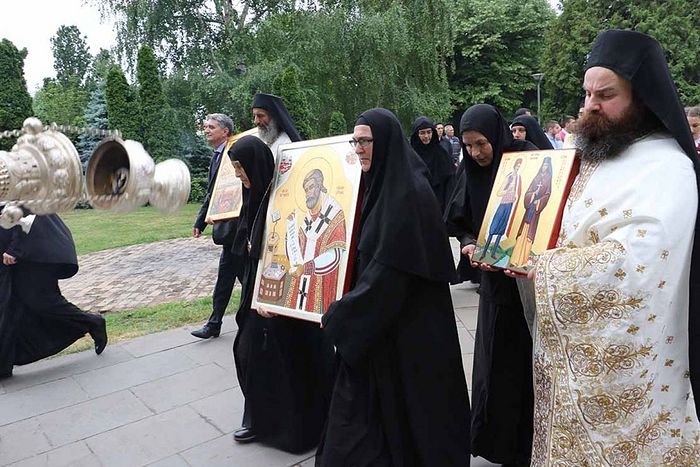 The glorification of the holy new martyrs in Belgrade
The glorification of the holy new martyrs in Belgrade
Over time, the Serbs arranged a grave and lit an inextinguishable lampada on it. А church later emerged over the place of the saint’s burial, near which, according to folk tradition, a small monastery was built (most likely a dependency of the Patriarchate of Peć). The monastery later suffered from Turkish barbarism, and the church was destroyed. But even after the destruction, the people didn’t stop going to the saint’s grave to pray to him. The remains of the church and grave were preserved all the way up until the war of 1999.
The veneration and memory of St. Vasilije and his grave are directly connected to the fate of the Serbian people of this region of Metohija and the surroundings of Peć.
***
At the end of the seventeenth century, after the Great Exodus of Serbs to the north of the Danube River in 1690 under the leadership of Patriarch Arsenije III Čarnojević, the makeup of the population of the region changed dramatically. The majority of Serbs left their age-old homes, and only a few Christian homes remained in the village of Ćuška itself. However, in the eighteenth century, Serbs from Montenegro and Macedonia moved there. Although the older residents relayed to their new neighbors the story of the martyrdom of St. Vasilije and the miracles that occurred at his grave, there was much greater veneration for the holy hierarch and wonderworker Basil of Ostrog among the immigrants from Montenegro, and therefore over time the names of the two saints began to be confused. A tradition appeared in the folk environment that the blood of St. Basil of Ostrog was spilled on the site of the grave of the New Martyr Vasilije when he was injured. Others claimed that the hand of the holy hierarch was buried there.
In spite of everything, the older residents and their descendants from the Peć region preserved the living memory of their fellow countryman, the holy New Martyr Vasilije the Baker.
Right next to the saint’s grave was a Turkish burial, in which, according to tradition, was buried a servant of Vasilije who remained loyal to him and took care of his grave after the death of his master. Over time, Turks and Albanians started coming to the saint’s place of rest. At some point, they even tried to appropriate the Serbian holy site for themselves because of the second grave belonging to a Muslim. They unsuccessfully tried to proclaim the Turk’s grave a holy place.
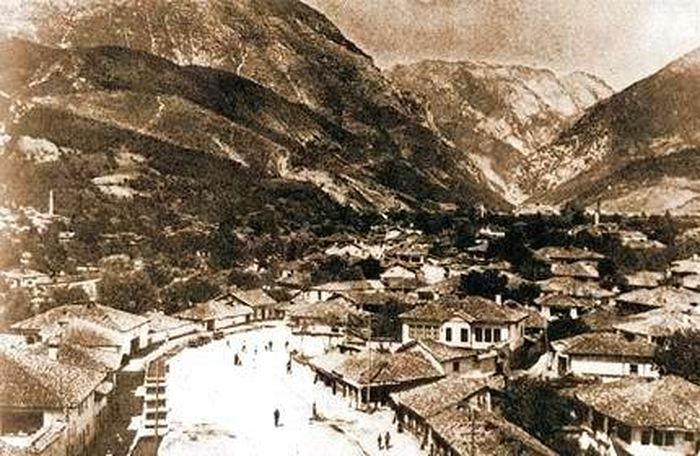 Peć in the period of Turkish rule
Peć in the period of Turkish rule
According to folk tradition and the customs of the local Serbs, they would go to St. Vasilije’s grave most often on Tuesdays and Fridays, but the most important day was that of St. Basil of Ostrog, when the holy martyr Vasilije the Baker was locally celebrated (similar to how the holy New Martyr Grigorije of Peć was celebrated on the day of St. Gregory the Theologian).
In 1959, Leonty Pavlović recorded the testimony of two Muslim women, Sabriya Salikh and Emina, who took care of the grave and told about how a large gathering of believers would also take place on the day of the holy Prophet Elias (July 20/August 2).
Typically, the people gathered at the grave in large groups, censing and lighting candles and praying together. The sick would be carried in procession thrice around the saint’s grave. A lampada, set up in a large depression, was always burning at the grave and could hold up to half a liter of oil. School students would often go straight to the grave with their textbooks so St. Vasilije would bless and help them in their studies.
Branca Mrenović (b. 1949) from Peć remembers how his reposed mother Tsveta Janicijević (1929-1998) would rouse him and his brothers and sisters early. They would get dressed up and go to St. Vasilije’s grave, located three to four miles from their home. There they would cense, light candles, and anoint themselves with oil from the lampada. Each prayed for himself, and, according to Branca, their prayers were always heard. Then they would have breakfast together not far from the holy site and would return home with the first rays of the rising sun, spiritually and physically strengthened.
From her early youth and right up to the 1999 NATO bombing, Dragića Popović would often visit the grave of the holy martyr Vasilije of Peć and pray to him for every need in life. The saint’s help, as she says, did not make her wait long, and every time she returned to the grave, she felt relief and peace.
Her friend Milka Djukić, with whom she often visited the grave of St. Vasilije in the mid-1960s, was convinced by personal experience that St. Vasilije was a speedy helper. After several years of marriage, her family life had broken down so much that her husband divorced her. Then her ex went to work abroad. Milka sought help from St. Vasilije: She prayed that her husband would return and not leave her alone with their two sons. After three months, her husband returned, and their restored marriage was crowned with the birth of another child—besides the two sons, they had a daughter. Today Milka is grateful to the speedy helper St. Vasilije.
Once Dragića Popović came across a young married couple from Bosnia at St. Vasilje’s grave (in the 1960s). They went there to offer a small gold chain as a token of gratitude. They had been married for four years, and not having any children, they prayed to St. Vasilije and had a son.
According to the testimony of Nun Evfimija (Marković), from the village of Nakla (near Peć), women from there and the neighboring villages had a custom of visiting the holy site on Sundays and Fridays at the beginning of the month, when, according to local tradition, the blessing of waters was celebrated. Some took on a more stringent rule of prayer on behalf of their relatives serving in the army, so they would return home alive and well. The Serbs and Albanians from Nakla would often go to the saint’s grave together in the morning.
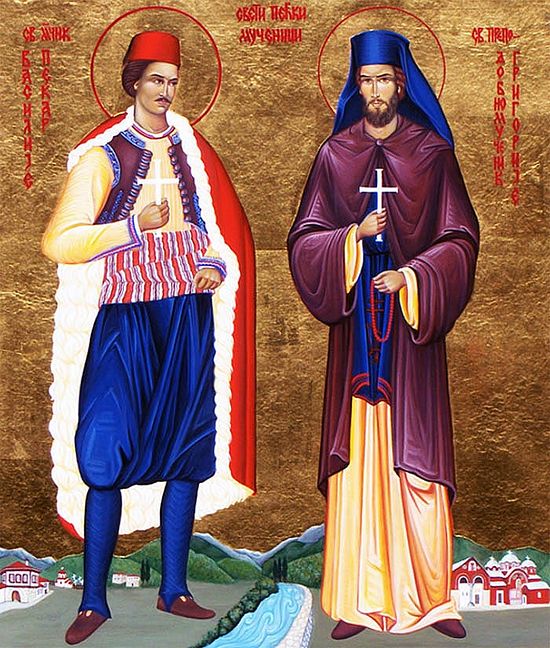 Martyr Vasilije and Monk-Martyr Grigoriije of Peć
Martyr Vasilije and Monk-Martyr Grigoriije of Peć
Dobrila Popović suffered from serious headaches in childhood. Her mother took her to St. Vasilije’s grave and anointed her with oil from the lampada. Her headache passed and has never happened again since then. Dobrila now lives in Kragujevac. She is sixty.
The residents of Nakla also knew that if a baby does not start walking, it’s necessary to take him to St. Vasilije, walk thrice around the grave with him, and the child will immediately take his first steps. There are several such cases that are known.
Radmila Marković (b. 1938 in the village of Lugodzhiya, near Peć) often saw her departed Muslim neighbor Zika in dreams in 1970, who would ask her for help. Radmila thought for a long time about how to help her, and in the end decided to go to St. Vasilije’s grave. She prayed for her neighbor there, and she never dreamed about her again.
Miloš Chukić’s (from Glavičice, near Peć) son suffered from infantile paralysis. As medicine proved unhelpful, Miloš took his sin to St. Vasilije of Peć and he fully recovered.
Mitra Miyatović (b. 1934 in the nearby village of Vitomiricë; now lives in the Peć Patriarchate) remembers that many would say then, “If slumber visits you at St. Vasilije’s grave, then you will be healed.” This happened with the grandson of Milunki Lazović, who now lives in Peć. She took her grandson to St. Vasilije’s grave in the early 1990s because he would often cry. She carried the boy three times around the grave, and after the third time he fell asleep. An Albanian who happened to be nearby said, “It’s good that you feell asleep. It will be alright…” And indeed, after that, the child didn’t cry anymore.
Mirjana Todorović from Peć has lived in Belgrade since 1999. She used to regularly visit the saint’s grave and pray to him for every need. One time a healing occurred with her. A small ulcer had appeared on her leg, and the serious pain on that spot tormented her. She didn’t turn to doctors, but immediately went to St. Vasilije and went around his grave three times. She anointed the painful spot with oil from his lampada each time. The pain went away, and soon the ulcer closed up. She well remembers the custom when people would take food to the grave and arrange meals there.
Viktoria Tanjević, Blaženka Čučić, and Radmila Sugović also remember their trips to St. Vasilije’s grave, and Lubića Milatović testifies that both Serbs and Albanians would go to New Martyr Vasilije’s grave, and that people often brought some personal items to bless them on the grave.
In the mid-1980s, the Albanians tried to limit access to the holy site for the Serbs. Nun Evfimija recalls that in 1985 St. Vasilije’s grave was enclosed by a lattice fence so it was impossible to get near it. According to her, the Serbs “Would just look at it from the bus when they were returning from school.”
This prohibition, however, only continued for a time. Many residents of Peć would go to the grave until 1999, when, according to the recollections of Branca Mrenović, the Albanians again fenced it in. Mirijana Todoroić, who worked nearby, passed by the site daily and recalls that in 1990 she saw how construction began over both graves. At that time she thought it was for a church.
Today you can see a new mosque on the site. At the same time, it is impossible to say for sure whether it covers the grave or is simply located in the immediate vicinity, but an examination of the place is difficult.
What really happened to the grave of St. Vasilije in the last years before the war is perhaps best testified to by the story of two friends from Peć—the Serb Dragića Popović and the Albanian Sharibana Plunči, who often went to the saint’s grave to pray, each in his own way. Sharibana would even often go pray at the Peć Monastery.
Once in 1998 they went to the saint’s grave and found it redesigned in an Albanian style. A long stone was laid on the grave, as usually stands on Albanian graves, and a lot of dirt was dug out around it, so it looked like a hill, as if someone had just been buried. A typical Balkan Muslim mausoleum tomb—a türbe—was set up. Sharibana asked the Albanian watchman why he did it. He replied, “They ordered it,” referring to the members of the UÇK combat organization, the so-called “Kosovo Liberation Army.” According to him, some man came and gave him an order for how to arrange everything. The women prayed and left, and several days later they went to Vasilije’s grave again and found that everything had been returned to its original state. When Sharibana asked what had happened, the guard answered, “You can’t order God. The same man came again and ordered to return everything back to how it was, because he was tormented at night and couldn’t sleep.”
By the prayers of the holy martyr and wonderworker Vasilije of Peć, O Lord Jesus Christ our God, have mercy upon us. Amen.

